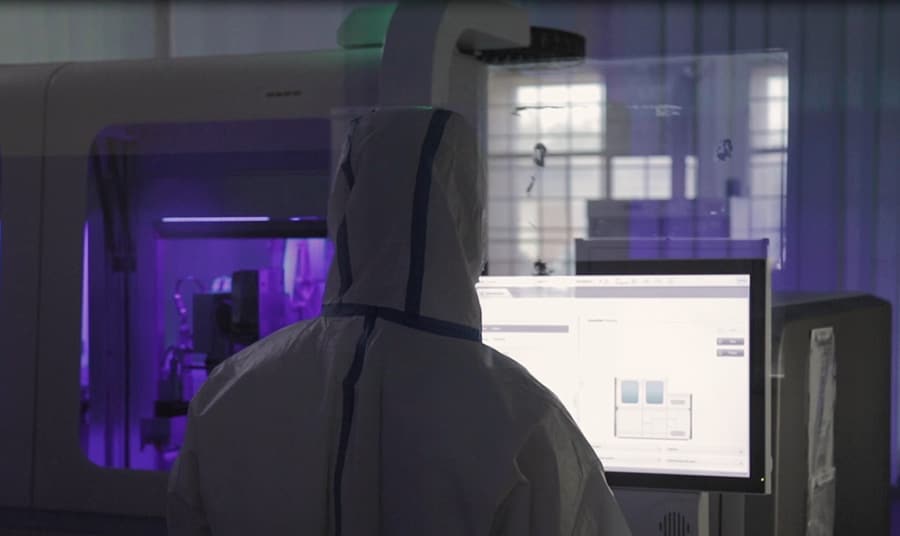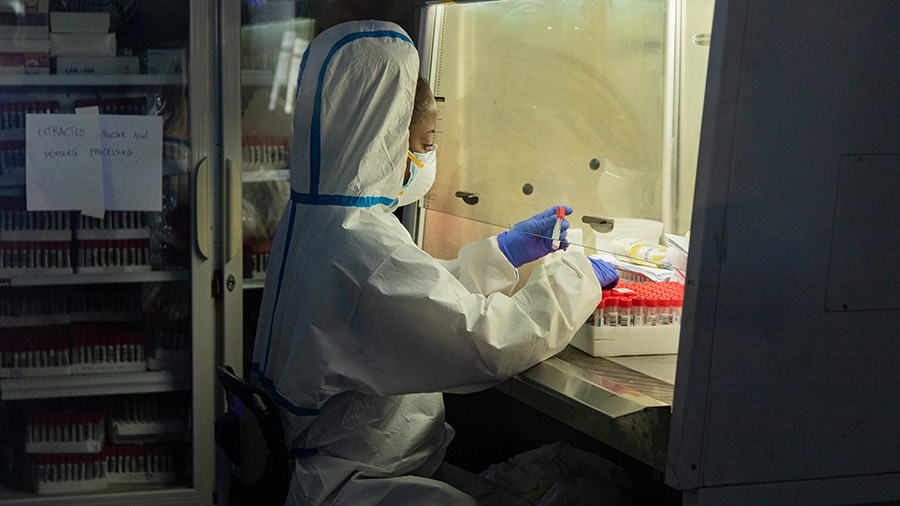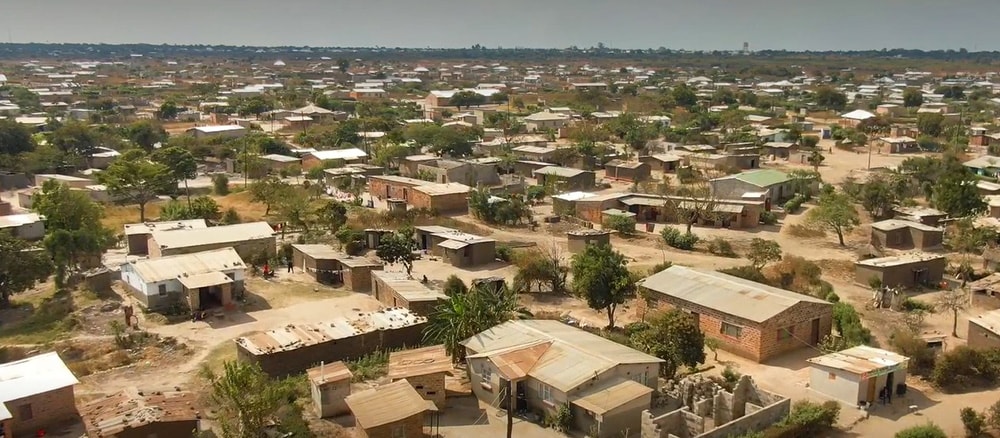CDC and Local Public Health Experts Team Up to Take On COVID-19 in Zambia
Summary
- During the COVID-19 pandemic, U.S. CDC collaborated with Zambian public health experts to support the COVID-19 response and keep people safe.
- Preparing laboratories to process COVID-19 tests was a top priority for the U.S. CDC team in Zambia.
- Zambian researchers published the first representative study in Africa that shows many more people had COVID-19 than official numbers revealed.
- Researchers also studied how Zambians can benefit from getting the COVID-19 vaccine, which is important because most clinical trials were done outside Africa.
- A CDC-supported Ministry of Health (MOH) program provided three or six months of medications so patients with HIV could stay at home without interrupting their treatment.
The U.S. Centers for Disease Control and Prevention (CDC) and Zambia’s Ministry of Health (MOH) have worked together to protect the public’s health since 2000, long before Zambia’s first COVID-19 cases were identified on March 18, 2020.
“COVID-19 has been a big challenge for many of us because it has the potential to threaten all the work that we’ve accomplished to improve the life of Zambians,” says Simon Agolory, MD, Country Director for the U.S. CDC office in Zambia until May 2022.
Zambia’s government acted quickly to limit the spread of COVID-19. It restricted travel into the country and shut down public gathering places like restaurants and churches. The MOH told residents to stay home as much as possible.
Agolory and his counterparts at the MOH recognized that continuing regular health services during the pandemic, including treatment for people living with HIV, was essential but challenging.

A lab technician is dressed in full personal protective equipment inside a lab that processes COVID-19 tests at the Tropical Disease Research Centre in Ndola, Zambia, in September 2021. U.S. CDC Zambia provides training and technical assistance to this and other labs in Zambia’s leading hospitals. Photo by Gyven Ngosa for CDC.
Ensuring Access to HIV Treatment During the COVID-19 Pandemic
For people who need HIV treatment, staying at home during the pandemic was not a good option, because they needed to go out to get their medications at clinics or dispensaries.
To address this challenge, CDC supported a MOH program that provided enough medications for people living with HIV so they could get through three or six months of staying at home without interrupting their treatment.
Agolory says the partnership with the MOH was instrumental in preventing more deaths during the pandemic.
CDC’s office in Zambia also partners with local faith-based organizations – like Circle of Hope – to provide information to people in their communities on what they can do to prevent getting COVID-19 or HIV.
“We’re working with over a thousand pastors, priests, and imams across Zambia, particularly for the messages of hope, encouragement, and to ensure that the citizens who are confronted HIV and COVID-19 have sufficient information to ensure that they stay negative,”
Establishing COVID-19 Testing in Zambia
Getting coronavirus testing set up in Zambia was a top priority for CDC Zambia. The team collaborated with the University Teaching Hospital (UTH) and Tropical Disease Research Centre (TDRC) so they could start COVID-19 testing in Zambia and greatly expand testing ability in the region.
UTH is Zambia’s main teaching hospital for doctors, nurses, and other health professionals. It is also the largest hospital in the nation’s capital, Lusaka.
“The UTH Virology Laboratory has received over a decade of support from the CDC Global Influenza Program to establish influenza surveillance in the country,” says Mwaka Monze, PhD, Head of Virology at the University Teaching Hospital.
This lab could test for the coronavirus because the same technologies used to diagnose the flu (influenza) are used to diagnose COVID-19.

A lab technician works on COVID-19 tests in the virology laboratory of the University Teaching Hospital in Lusaka, Zambia, in September 2021. Originally built to test flu samples, this lab was converted for COVID-10 testing. Photo by Jason Mulikita for CDC
“I think the laboratory is an essential part of the response,” says Monze. “We are able to identify who is infected and isolate them because we are able to test.”
The U.S. CDC team also supported the expansion of testing at the TDRC located in Ndola, roughly 200 miles north of Zambia’s capital. Agolory and his colleagues shared their expertise to help set up a lab for COVID-19 testing and train the TDRC staff.
Support from CDC Zambia allowed the TDRC lab to increase the number of samples they could test each day.
“In addition to early diagnostic support over the course of the pandemic, eventually all 24 viral load labs equipped and supported by the U.S. President’s Emergency Plan for AIDS Relief (PEPFAR) for HIV treatment monitoring were also used for COVID-19 diagnostics,” says Sam Yingst, DVM, PhD, CDC’s chief of laboratory infrastructure and support in Zambia. “More than one million SARS-COV-2 PCR assays have now been run in those labs.”

Aerial view of Zambia’s capital Lusaka, where the U.S. CDC’s Zambia team supports COVID-19 testing capabilities. Photo by Gyven Ngosa for CDC.
CDC Zambia Provides Support for COVID-19 Studies
In July 2020, three months after COVID-19 was first detected in Zambia, the number of people getting sick from the virus was increasing quickly. So the MOH launched a study to better understand how many people were getting infected.
The U.S. CDC office in Zambia supported the MOH with technical advice and funding for the research. Yingst and his CDC colleague Jonas Hines, MD, helped the MOH design and start the study, including defining how data would be collected, managed, and analyzed.
The researchers conducted the study in six districts of Zambia where about one quarter of the country’s population lives. It was designed to better understand how many people were getting COVID-19 in these districts. This information would be used to improve the COVID-19 response in Zambia and ultimately save lives.
This is the first representative study in Africa to show how prevalent COVID-19 was in a population. It was published in the medical journal “Lancet Global Health.”
Hines, who studies the causes and effects of diseases as a medical epidemiologist in CDC’s Zambia office, says the study results provide important information for Zambia and sub-Saharan Africa.
“We found that even though fewer cases were being reported, there were many cases occurring that were going undetected,” says Dr. Hines. This is not unusual, he adds. “Most diseases are undercounted when doing surveillance.”
The study results provided evidence to put an end to a common myth that countries in Africa had been spared from the pandemic.
“In this study, only one case was reported for every 92 infections that occurred in the community,” says Hines. “One reason for that may have been because there were many asymptomatic infections.” Hines says the research showed that three out of four people did not have any symptoms while they had COVID-19.
“An important finding from our study is that COVID-19 infections were more geographically widespread than the routine surveillance data indicated,” says Hines. These results were confirmed in later studies in Africa which showed similar rates of people who had COVID-19 but did not look or feel sick. Lloyd Mulenga, MD, a professor of infectious diseases at UTH and the lead author of this study, says the research helped Zambia prepare for the second wave of COVID-19.
Zambian Study Shows COVID-19 Vaccine Helps Zambians
CDC supported another study with the Field Epidemiology Training Program (FETP) under the Zambian National Public Health Institute (ZNPHI) to provide real-world evidence of vaccine effectiveness. John Simwanza, MD, a FETP resident, led the investigation in December 2021 after learning of a COVID-19 outbreak in a Zambian prison shortly after Zambia detected the Omicron variant.
Among the 382 prisoners participating in this study, 75% were fully vaccinated.
Researchers found that vaccinated prisoners were 65% less likely to get COVID-19, and those vaccinated who did test positive were 73% less likely to have symptoms. None of the vaccinated prisoners had severe COVID-19 symptoms or died.
Simwanza says, “These findings are important for Zambia because most clinical trials were done outside Africa.” The results of this local study can be used to increase COVID-19 vaccination in Zambia and other African countries.
The study also shows how the U.S. government’s partnership with ZNPHI strengthens the public health sector in Zambia.
Benefits of Collaborating on Laboratory Testing and Surveillance
CDC Zambia’s support for laboratory testing and surveillance were important parts of the COVID-19 response in Zambia.
“Surveillance relies heavily on laboratory testing” says Monze. She says with this laboratory testing capability, health officials have a better idea of how many COVID-19 cases there are, which influences what they have to do next.
“We have a system now in collaboration with the government and the Ministry of Health here in Zambia, to continue to identify new variants, new localized outbreaks, and address the issues together,” says Yingst. “Not only can we as Americans work with Zambia to protect our own country, but we can work globally to protect each individual country from this current pandemic and future pandemics.”

A laboratory technician returns COVID-19 samples to a -80°C freezer in the virology laboratory at the U.S CDC supported University Training Hospital in Lusaka, Zambia. The samples stored here are used for future reference or studies. Photo by Jason Mulikita for CDC